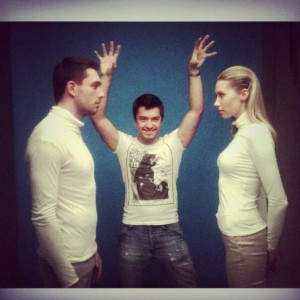Interview Series: Lev Dolgachov Published on by luis in Best-Of Articles, Interviews
This week we meet Lev Dolgachov, a tireless photographer bursting with energy who has setup an efficient production workflow with a lot of success.
We are very happy to welcome him in our series and read on if you want to know why you should leave your comfort zone!
Discover hisportfolio here.
Thank you very much for participating in our series of Stock Performer customer interviews!
Thank you for inviting!
Tell us, where do you live and where are you from? Is that where you produce your photography?
Syda Productions is based in Tallinn, Estonia, Northern Europe. Naturally, that’s where we produce mostly everything at this moment.
When did you discover your interest in photography?
I believe it was in 1985, maybe 1986, as a hobby. Ever since i kept coming back to photography over and over some way, until it finally became a business for me several years ago.
How did you find microstock and why did you get involved? Has it changed your life?
As a hobbyist, I never considered my work having any commercial value. Microstock changed this forever. I sold my existing business then and dedicated myself 100% to the photography business.
Thank you for image! What inspired you to take this picture?
It was actually a fashion shoot. Model released, but I did not really intend to get a lot of stock worthy pictures. It was something that should have ended as another magazine editorial. So this particular picture was a part of an editorial showing Tallinn under different angles, where every picture had some famous place feeling. I think this picture was “New York”.
We didn’t care about superb technical quality at the first place, it didn’t matter much. I believe I used ISO3200 and a long exposure here. Then Alexander, one of our team members, who is a retoucher, played a bit with Photoshop, cropped the original, changed colors and we’ve got what you see. Nice picture with 4Mp size and ISO3200 noise. Something that should never be accepted on stock sites.
When we submitted it for sale, I never believed it would pass the initial inspection. Well, it did. Everywhere! And we see it everywhere in the media now, including major brand commercials and every possible sort of apparels. Designers just love it.
 What does this image’s revenue chart tell you?
What does this image’s revenue chart tell you?
Sustainable sales for 3 years. You can notice a peak on the red line. That’s when this picture was free image of the week on Shutterstock. Those are not free downloads though – it was extremely popular with regular sales the very same week, thanks to good publicity.
Did you expect such a revenue chart? Are you happy with it?
We are always happy with pictures that have sustainable high sales over a long time. Of course, we are absolutely happy with the performance of this image.
The microstock market is huge. How do you analyse the market? Is it an important part of your workflow?
Yes, it’s one of the most important parts of the process. Producing stock involves a lot of mathematics and statistics. You should be more than familiar withRPI’s, RPD’s, STR’setc. You should know what the market wants. You should know what your competitors do. If you intend to be a leader, you should analyze everything 24/7. Be as much an “industry insider” as possible.
To make an internal analysis and check the performance of our shoots we useStock Performer. Our large amounts of data does sometimes push Stock Performer to it’s limit!
Do you believe in “quantity” or “quality”? What is most important for you and why?
Commercial value. Period. Quantity and quality are just multiplicators. Commercial value is king.
What does your typical production process look like?
Long story short, it’s “Analyze – Plan – Shoot – Edit – Submit”. No rocket science. Still needs a lot of effort and a lot of teamwork in most stages.
Would you recommend photographers to take risks and invest in employees or assistants, or outsource, to help them in their production process?
It’s always hard to justify if it’s worth for someone else to take the risk and invest. Once we’ll be ready to give investing advice, we’ll start an investment advice consulting business.
But since you ask, I would say : “If you already have a good background in business building, you can give it a try. If you’re not, this industry is not the safest playground for learning. Not any more. Chances are, you will most likely fail.”
For me, personally, building a team was worth it. I think the greatest value of our company is its team. I would never be able to have go alone to where we are now and where we are planning to go soon. I believe we have an amazing team. I’m lucky.
Where do you think the stock photography business is going? How do you see the next years?
Exciting and relentless times are ahead. Tough competition on the high-end level. Demotivatingly decreasing revenues on the lower-end.
What is your advice to remain a successful stock photographer in upcoming years?
Have no mercy. At the very first to yourself. Forget about the idea of a “comfort zone”. There is no comfort zone in the microstock industry any more. Expect the best but always be prepared for the worst.
Tell us, when you are not doing photography, how do you relax and enjoy your free time?
Business is always on my mind, even when relaxing. Free time? Well, self-education, sports car racing, playing punk rock on my guitar, travelling. Go name it all.
I mostly tend to enjoy strange things, like wandering around the darkest streets of Shanghai in the night, eating fish eyeballs in Tokyo’s most hidden place, voluntarily spending a week in the strangest blocks of Brooklyn or swimming with pigs (check youtube forswimming pigs in Exuma, it’s real fun). So, mostly travel and all sorts of adventures.
Thank you very much for your time, it was a pleasure talking to you!
The pleasure is mine. Thank you!
If you haven’t joined Stock Performer yet, join the free trial now!
You enjoyed this interview? Then read more here:

